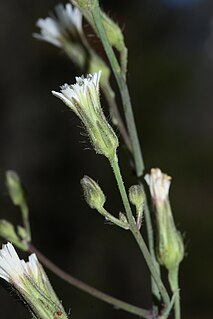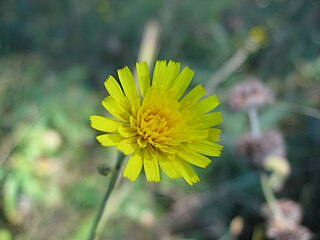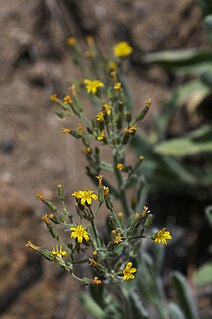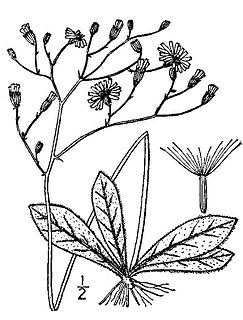
Snowdonia is a mountainous region in northwestern Wales and a national park of 823 square miles (2,130 km2) in area. It was the first to be designated of the three national parks in Wales, in 1951.

Pilosella aurantiaca is a perennial flowering plant in the daisy family Asteraceae that is native to alpine regions of central and southern Europe, where it is protected in several regions.

Hieracium , known by the common name hawkweed and classically as hierakion, is a genus of flowering plant in the sunflower family Asteraceae, and closely related to dandelion (Taraxacum), chicory (Cichorium), prickly lettuce (Lactuca) and sow thistle (Sonchus), which are part of the tribe Cichorieae. Hawkweeds, with their 10,000+ recorded species and subspecies, do their part to make Asteraceae the second largest family of flowering plants. Some botanists group all these species or subspecies into approximately 800 accepted species, while others prefer to accept several thousand species. Since most hawkweeds reproduce exclusively asexually by means of seeds that are genetically identical to their mother plant, clones or populations that consist of genetically identical plants are formed and some botanists prefer to accept these clones as good species whereas others try to group them into a few hundred more broadly defined species. What is here treated as the single genus Hieracium is now treated by most European experts as two different genera, Hieracium and Pilosella, with species such as Hieracium pilosella, Hieracium floribundum and Hieracium aurantiacum referred to the latter genus. Many members of the genus Pilosella reproduce both by stolons and by seeds, whereas true Hieracium species reproduce only by seeds. In Pilosella, many individual plants are capable of forming both normal sexual and asexual (apomictic) seeds, whereas individual plants of Hieracium only produce one kind of seeds. Another difference is that all species of Pilosella have leaves with smooth (entire) margins whereas most species of Hieracium have distinctly dentate to deeply cut or divided leaves.
A dry roadside dotted with small, ¾ inch red orange flowers, interspersed with very similar yellow ones, and often the white of daisies, is a good sign that you are in Hawkweed country.

Pilosella officinarum, known as mouse-ear hawkweed, is a yellow-flowered species of flowering plant in the daisy family Asteraceae, native to Europe and northern Asia. It produces single, lemon-coloured inflorescences. Like most hawkweed species, it is highly variable and is a member of a species complex of several dozens of subspecies and hundreds of varieties and forms. It is an allelopathic plant.

Pilosella albiflora is a common and widespread North American plant in the sunflower family, known by the names white hawkweed and white-flowered hawkweed.

Hieracium umbellatum, the Canadian hawkweed, Canada hawkweed, narrowleaf hawkweed, or northern hawkweed, is a flowering plant in the daisy family Asteraceae.

Cwm Idwal is a cirque in the Glyderau range of mountains in northern Snowdonia, the national park in the mountainous region of North Wales. Its main interest is to hill walkers and rock climbers, but it is also of interest to geologists and naturalists, given its combination of altitude, aspect (north-facing) and terrain. In a 2005 poll conducted by Radio Times, Cwm Idwal was ranked the 7th greatest natural wonder in Britain.

Hieracium lucidum, or Sicilian sparviere, is a flowering plant in the aster family. It is very similar to Hieracium cophanense. Hieracium lucidum is a perennial herb that prefers the northern slopes of chalky seaside cliffs exposed to wet winds, including sites rich in nitrates from sea bird droppings. Unlike most other hawkweeds, this species reproduces only from seeds.

Hieracium lachenalii, also known as common hawkweed or yellow hawkweed, is a species of plant in the dandelion tribe within the sunflower family. It is native to Europe but has become established as a weed in Australia and parts of North America. The species was widely known for many years as H. vulgatum, but more recent studies have indicated that the two names represent the same species. The name H. lachenalii was coined in 1802, H. vulgatum in 1819, so the older name is to be used.

Pilosella caespitosa is like several other Pilosella species and has a similar appearance to many of the hawkweeds.

Hieracium sabaudum, also known as New England hawkweed, European hawkweed or a Savoy hawkweed, is a European species of plants in the dandelion tribe within the sunflower family. It is native to Europe but has become naturalized in parts of North America. In Canada, it grows in British Columbia, Québec, and Nova Scotia. In the United States, it has been found in Washington state in the Northwest as well as Wisconsin and the Northeast. The species is considered a noxious weed in Washington state.

Hieracium albertinum, known as western hawkweed or houndstongue hawkweed, is a species of the genus Hieracium that is very similar to Hieracium albiflorum with white flowers but differs in that the flower heads are clustered and the leaves, stems and bracts are covered in a thick layer of hairs. Standing 1 inch (3 cm) to 5 inches (13 cm) tall, it can be found blooming from June through August in forest clearings.

Pilosella horrida, known as the prickly hawkweed or shaggy hawkweed, gets its name from the long, dense, shaggy white to brown hairs (trichomes) which cover all of the plant parts of this plant species. The species is native to Oregon, California, and Nevada in the western United States.

Radyr hawkweed is the common name of Hieracium radyrense, a very rare endemic species restricted to Radyr in south Wales, UK. First identified in 1907 it was described as a variety in 1948 and a species in 1955. and belongs to Hieracium section Vulgata. It has rarely been seen and surveys between 1998 and 2004 indicate that only one population of about 25 plants survives.

Oxyptilus pilosellae is a moth of the family Pterophoridae first described by Philipp Christoph Zeller in 1841. It is found in most of Europe, east to Russia and Asia Minor. It was released as a biological control agent for Hieracium in New Zealand in 1998.

Hieracium venosum is a species of hawkweeds in the dandelion tribe within the sunflower family. It is widespread and common in south-central Canada (Ontario) and the eastern United States. Its common name comes from the fact that environments it is found in are typically also a home to rattlesnakes.
Pilosella floribunda is a species of noxious and herbaceous perennial plant from family Asteraceae that is known in Europe and can also be found in United States and Canada. It was believed that it was a hybrid of Pilosella caespitosa (Hieracium caespitosum and Pilosella lactucella.
Hieracium hethlandiae, known as Cliva Hill hawkweed, is a species of hawkweed native to Shetland. The species was first published in 1946.














